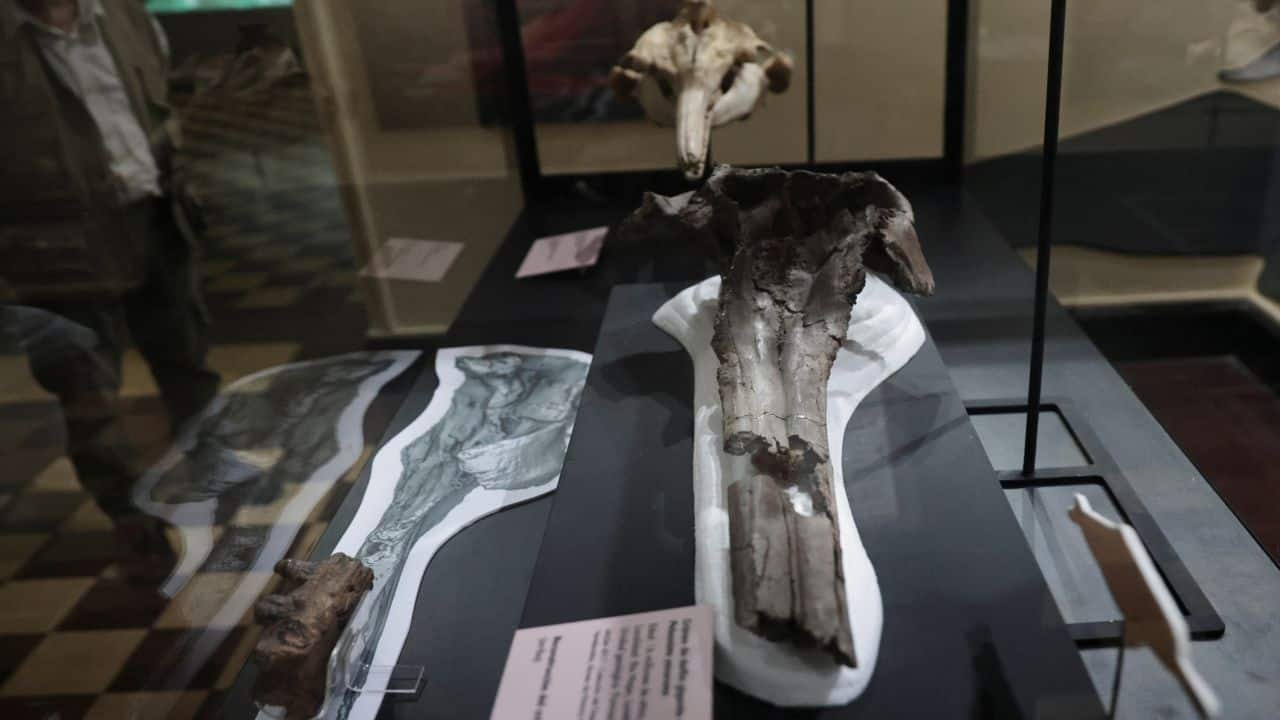16-Million-Year-Old skull in Peru reveals new extinct species of an ANCIENT giant dolphin

This artistic interpretation shows what Pebanista yacuruna might have looked like some 16 million years ago.
In 2018, Aldo Benites-Palomino was walking along the Napo River in Peru during a field expedition, when he spotted part of a fossilized jaw bone poking out of a rocky outcropping.
“As soon as I recognized it, I saw the teeth sockets,” says Benites-Palomino, a paleontologist at the University of Zurich, to the Guardian’s Sophie Kevany. “I screamed, ‘This is a dolphin.’ We could not believe it.”
:focal(760x480:761x481)/https://tf-cmsv2-smithsonianmag-media.s3.amazonaws.com/filer_public/d0/3e/d03e928c-6c7c-4f9a-b920-0e34f5618f38/article_giant_freshwater_dolphin_1.jpg)
Benites-Palomino and his collaborators knew they’d found something special that day while exploring part of the Peruvian Amazon. But they didn’t know just how special, until they studied the fossil more closely.
It belonged to an extinct species of freshwater dolphin that could grow to up to 11.5 feet long, making it the largest freshwater dolphin scientists have ever found, the team reports this week in the journal Science Advances.

They named the previously unknown species Pebanista yacuruna in honor of a mythical aquatic people, known as the Yacuruna, believed to live in underwater cities throughout the Amazon basin.
In addition to its size, P. yacuruna was also significant for its family tree. Because researchers found the fossil in the Amazon basin, they expected P. yacuruna’s closest living relatives to be modern Amazon river dolphins, also known as pink river dolphins or botos.

But instead, they learned the extinct creatures were more closely related to the river dolphins that swim in the Ganges and Indus rivers of South Asia, some 6,200 miles away.
The researchers can’t explain this surprising relationship, but it may offer new insights into the evolution of freshwater dolphins.

They are “especially intrigued by [P. yacuruna’s] peculiar biogeographical deep-time history,” says study co-author Marcelo R. Sánchez-Villagra, also a paleontologist at the University of Zurich, in a statement.
P. yacuruna lived some 16 million years ago. At the time, the massive Amazon River that today flows east to the Atlantic hadn’t formed yet.

Instead, the region was covered with a series of swamps and lakes known as the Pebas mega-wetland system. This semi-aquatic ecosystem stretched across present-day Colombia, Ecuador, Bolivia, Peru and Brazil.
Learning more about the region’s ancient plants, animals and landscape is “crucial to understanding the history and pathways that led to the remarkably rich modern Amazonian biodiversity,” says study co-author John J. Flynn, curator of fossil mammals at the American Museum of Natural History, in a statement.
/https://tf-cmsv2-smithsonianmag-media.s3.amazonaws.com/filer_public/9a/b4/9ab4125c-0417-4f44-a2e0-938f63c76990/pebanista-yacuruna-holotype-1400-1212_full_1220.jpg)
The fossilized jaw of Pebanista yacuruna and a surface 3D model, below.
The ancient dolphin had small eyes and a bony structure called a facial crest that allowed it to “see” by using echolocation, similar to today’s dolphins. Together, these characteristics suggest P. yacuruna lived in muddy waters.

P. yacuruna also had large teeth and a long snout, which indicates it was feasting primarily on fish. Like other freshwater dolphins, P. yacuruna’s ancestors likely first lived in the ocean, then moved inland to freshwater habitats in search of new sources of food. Over time, these dolphins evolved adaptations that helped them succeed in their new environment.
Why did they disappear? Scientists don’t know for sure, but they suspect changes to the landscape likely killed off their prey, which ultimately pushed the dolphins to extinction.
/https://tf-cmsv2-smithsonianmag-media.s3.amazonaws.com/filer_public/5e/1f/5e1f3bcb-c4db-41d2-a19b-4d387e8bd5f6/aldo_benites_palomino_preparing_the_skull.jpg)
Aldo Benites-Palomino found the skull during a field expedition in 2018.
“Around 11 to 12 million years ago, this mega-wetland system started to drain, giving way to the modern Amazon,” Benites-Palomino tells New Scientist’s Corryn Wetzel. “A lot of species disappeared at that moment, and that might also have been the fate of this giant dolphin.”

Though the ecological changes were bad for P. yacuruna, they were a boon to the ancestors of today’s living Amazon river dolphins. They left the oceans—which were becoming increasingly crowded with new cetaceans—to retreat to this new, abundant freshwater habitat, where they still live today.
Today, the P. yacuruna skull is on display at the Museum of Natural History in Lima, Peru.









